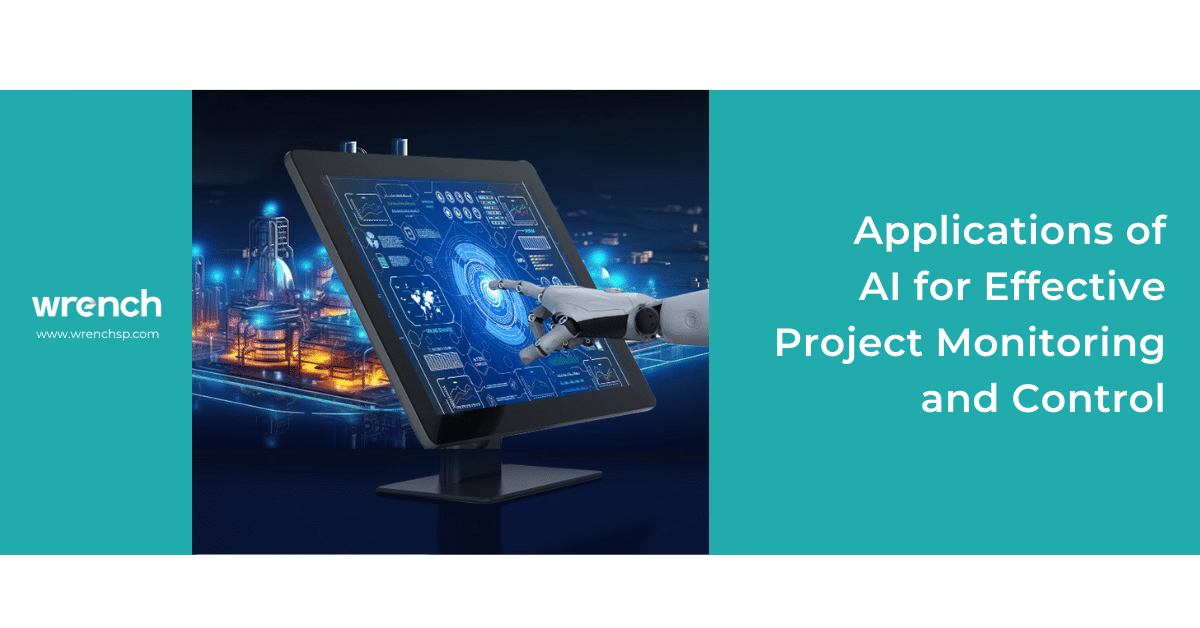- AI Blog Project control Project Monitoring
- 21 Jun 2024
Applications of AI for Effective Project Monitoring and Control

Project monitoring and control of EPC projects are dynamic tasks, because each project has its own unique challenges that have to be addressed and resolved. For that reason, project management would be far more effective and predicable if you had a reliable way to capture knowledge in data form and analyse that data into useful information that would help toward better decision-making. That brings up the question of AI and how it can be leveraged in project monitoring and control.
AI-based project monitoring and project controls can be a game-changer in modern EPC projects. An AI-based project monitoring system would be able to ‘learn’ about the way a company handles resource management, project scheduling, supply chain management, quality, and safety from past project data and would be able to analyse those learnings to improve future outcomes. By teaching the system Machine Learning algorithms based on historical data, it is conceivable that an AI-based system would be able to analyse various potential possibilities and suggest the most suitable option. In this way, past data/knowledge can help an AI-based system correct previous mistakes and predict future outcomes with a high degree of accuracy, and also significantly optimize planning, resource management, and real-time decision-making.
Let’s break down the areas of application of AI in project monitoring:
1. Predictive Analytics:
Forecasting Demand: Analyze historical data of the various work packages and predict material, labor, and equipment needed in future, thereby ensuring that resources are available when needed.
Identifying Risks: Identify potential risks and bottlenecks by analyzing patterns and trends, thus allowing for proactive risk mitigation.
2. Scheduling Optimization:
Dynamic Scheduling: Optimize project schedules by adjusting task sequences and resource allocations in real-time, thus minimizing delays and maximizing efficiency.
Scenario Analysis: Simulate different project scenarios to determine the best course of action, thus helping planners to make informed decisions.
3. Resource Management:
Automated material Tracking: Track material usage and availability in real-time to ensure timely replenishment, thus reducing shortages.
Equipment Utilization: Optimize equipment usage by predicting maintenance needs and scheduling downtime, thus reducing idle time and improving availability.
4. Supply Chain Optimization:
Supplier Performance Analysis: Evaluate supplier performance based on delivery times, quality, and reliability, thus helping to select the best suppliers and negotiate better terms.
Just-In-Time Delivery: Coordinate with suppliers to ensure materials get delivered just in time, thus reducing storage costs and minimizing delays.
5. Site Monitoring and Management:
Real-Time Data Collection: Drones and IoT sensors can collect real-time data on site conditions, progress, and resource utilization, thus providing actionable insights for project managers.
Automated Inspections: Automate site inspections to identify potential issues, thus ensuring work fronts are ready for the next phase of construction.
6. Communication and Collaboration:
Virtual Assistants: Virtual assistants can facilitate communication and coordination among project stakeholders, thus ensuring everyone is informed and aligned.
Document Management notification: Ensure access through automated notification about the latest information, thus reducing delays caused by outdated or missing documents.
7. Quality Control and Safety:
Defect Detection: Analyze images and data from the construction site to detect defects and quality issues early, thus preventing rework and delays.
Safety Monitoring: Monitor safety conditions on-site and predict potential hazards, thus ensuring a safe working environment and reducing accidents.
8. Optimizing Workflows:
Lean Construction: Help implement lean construction principles by identifying and eliminating waste, thus optimizing workflows and improving overall efficiency.
Continuous Improvement: Continuously learn from project data, thus providing insights for ongoing process improvements and better resource utilization.
From the above we can see that even a cursory analysis of the effects of an AI-based system on project monitoring shows immediate and tangible benefits that affect the entire project lifecycle and increase the chance of successful project delivery.
Related Posts

EDMS Features and Functions
When an EPC organisation, be it an owner, architect, contractor, or consultant, starts on a journey of digital transformation the first step is likely an EDMS or engineering document management system. The expectation is that…
- 10 Apr 2025

Engineering DMS vs Electronic DMS
The term EDMS has become commonplace in engineering-related sectors these days, especially in EPC project verticals where the management of technical documentation is a key factor in successful project delivery. It must be noted that…
- 04 Apr 2025
Archives
- April 2025
- March 2025
- February 2025
- January 2025
- November 2024
- October 2024
- September 2024
- August 2024
- July 2024
- June 2024
- May 2024
- April 2024
- March 2024
- January 2024
- December 2023
- November 2023
- September 2023
- August 2023
- July 2023
- June 2023
- May 2023
- April 2023
- March 2023
- February 2023
- January 2023
- December 2022
- November 2022
- September 2022
- June 2022
- May 2022
- April 2022
- March 2022
- January 2022
- November 2021
- October 2021
- July 2021
- June 2021
- May 2021
- March 2021
- February 2021
- January 2021
- December 2020
- November 2020
- September 2020
- August 2020
- June 2020
- April 2020
- March 2020
- February 2020
- January 2020
- November 2019
- October 2019
- September 2019
- August 2019
- April 2019
- March 2019
- December 2018
- October 2018
- September 2018
- August 2018
- July 2018
- June 2018
- May 2018
- April 2018
- January 2018
- November 2017
- October 2017
- September 2017
- May 2017
- April 2017
- March 2017
- February 2017
- January 2017
